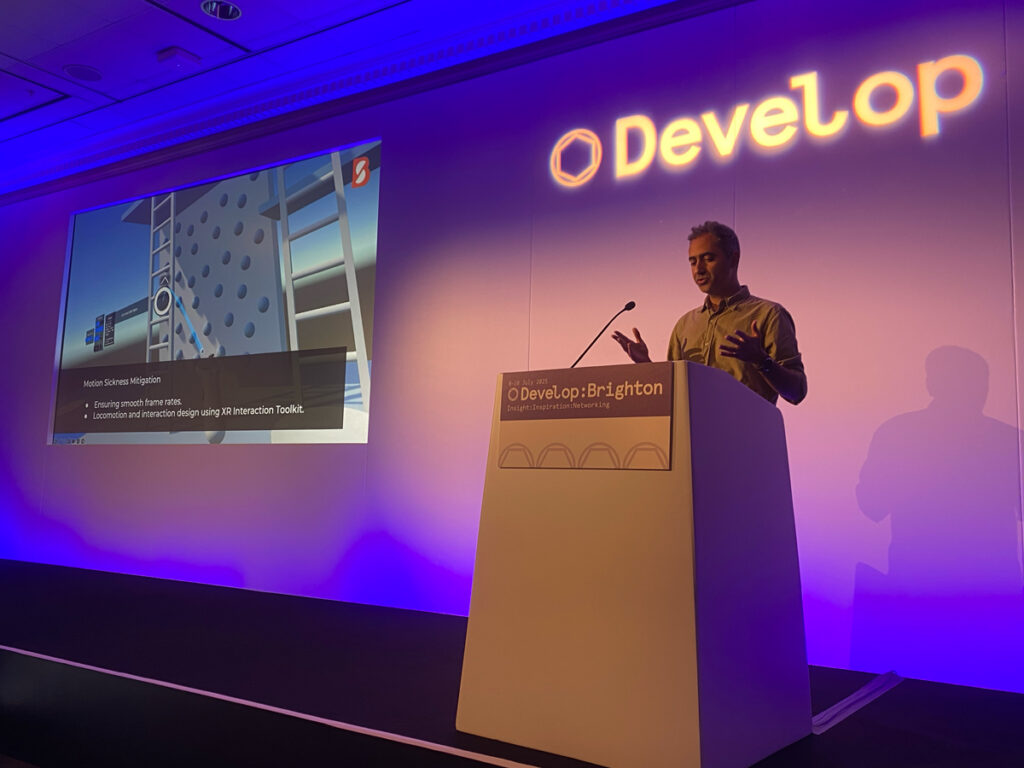Our Talk: VR Pipeline Essentials
Our session was scheduled near the end of the final day, and we were glad to see a room of developers, artists, producers, and students joining us for an honest and practical conversation about VR production. The goal was to share lessons learned from twelve years of immersive development at Sliced Bread Animation, especially in the healthcare and corporate training space.
Introduction and Background
Jamie began the talk by introducing our studio’s history, which started in animation and gradually moved into VR as the technology matured. Since our earliest projects with the Oculus DK1, we have developed interactive training and educational content across multiple platforms and headsets.
A key part of Jamie’s introduction was focused on what makes VR different from traditional media. In VR, the player is present, embodied, and reactive. You are not telling a story to a passive viewer. You are building a space that someone will step into, explore, and often behave unpredictably within.
To illustrate this, Jamie shared a story about testing our VR cooking simulation with his daughter. Instead of following the steps of the recipe, she decided to crawl into the oven. We had designed the kitchen with attention to detail, but never expected users to explore it in that way. That moment was a perfect example of how players claim agency in VR whether you plan for it or not.
Storytelling and Spatial Pacing
We then explored how important it is to guide the player without restricting them. This involves careful onboarding, meaningful audio cues, spatial layout that encourages exploration, and pacing that builds comfort before complexity. We talked about common mistakes developers make, including rushing movement sequences or not preparing users for a scene transition. Even something as simple as telling the user “We are moving now” can reduce disorientation significantly.
Jamie also emphasised that you have to define the player’s role early. Are they an observer, a participant, or a character within the world? If that is unclear, the experience quickly becomes confusing. Designing a VR narrative requires more than placing voiceovers and prompts. It requires spatial, emotional, and sensory awareness.
Pipeline and Process
The next section focused on the process. Jamie described how early in our VR work we ran into technical and visual alignment issues. For example, models reviewed and approved in Maya would look incorrect once inside Unity due to differences in lighting, shaders, or scale. This led to costly rework, especially on projects where accuracy was critical, such as medical visualisations.
We now approach pipeline planning with a structured methodology. This includes:
- Documentation and storyboarding before any major build work
- Prototyping user interaction flows before final content is created
- Cross-tool validation between modeling software and Unity
- Client-facing reviews that involve actual headset views, not just stills
We also listed five major pitfalls that affect many VR teams:
- Starting without a plan or prototype
- Overlooking motion comfort
- Using too many disconnected tools
- Leaving optimisation until the end
- Failing to test with real users during development
Technical Workflow
Soheil took over to present the technical side of the talk. He began by explaining how VR development builds on game development principles but raises the stakes on performance. Smooth frame rates are not just desirable in VR, they are essential to the experience.
Soheil shared our technical toolkit and optimisation practices, including:
- Reducing draw calls through static and dynamic batching
- Using Level of Detail (LOD) models to reduce load on distant objects
- Grouping textures into atlases to reduce material changes
- Baking lighting where possible instead of using real-time
- Monitoring CPU and GPU use with Unity’s built-in Profiler
- Avoiding overly complex physics setups, rigidbodies, and unnecessary colliders
He also explained how Unity’s XR Interaction Toolkit helps us streamline input, interaction, and locomotion across headsets. The toolkit gives us reusable systems for grabbing, poking, hovering, and navigating, and it supports both hand tracking and controllers. This means we can build a core experience once, and then deploy it across Meta Quest, Apple Vision Pro, and PC VR with minimal changes.
Soheil highlighted how we balance mobile VR constraints with PC VR potential. For mobile-focused projects like those built for Quest, we prioritise texture resolution, shader simplicity, and physics limitations early in the asset pipeline.
Motion Sickness and User Comfort
We then returned to the topic of comfort. Everything we do, from design to code, has to consider motion sickness. We use fade-ins, pre-motion audio cues, smooth locomotion, and stable camera systems. We also onboard the player with a controlled warm-up interaction, where they can learn movement and input without stakes or urgency.
We have found that even experienced VR users benefit from clear pacing. For new users, it is essential. Comfort is not a bonus feature in VR. It is part of the core design.
Q&A and Audience Interaction
The audience Q&A brought great energy and thoughtful questions. Topics included:
- Handling garbage collection and avoiding freezes
- Using VFX without compromising performance
- Building UI for non-gamer users in training contexts
- Dealing with unclear or shifting client briefs
- Teaching users through environment instead of overlays
We shared how we use small gestures and low-pressure interaction sequences to onboard users. For clients unfamiliar with VR, we often build interaction prototypes early to establish shared understanding. That prevents surprises later in production and helps refine expectations collaboratively.









